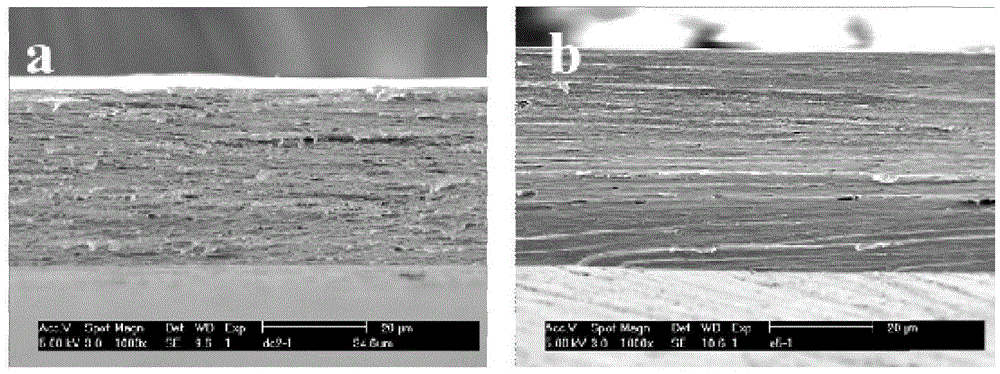Preparation method of cornea repair material of double-layer structure
A repair material and a double-layer structure technology, applied in the fields of medical devices, cosmetics, and biomedical materials, can solve the problems of unable to support tissue reconstruction, difficult to shape, poor mechanical properties, etc., achieve good light transmission effect, simple preparation process, The effect of high production efficiency
- Summary
- Abstract
- Description
- Claims
- Application Information
AI Technical Summary
Problems solved by technology
Method used
Image
Examples
Embodiment 1
[0029] 1 g of PVA with a molecular weight of 13000-23000 was added to 10 ml of deionized water, and stirred in a constant temperature oil bath at 95° C. for 2 hours to obtain a PVA solution. Leave to stand at room temperature, pour into a glass mold, and dry naturally to form a film at room temperature. Use 0.3wt% acetic acid solution to prepare 100ml of 0.5wt% collagen solution; after fully stirring, spread the collagen solution evenly, dry and shape to obtain a PVA / collagen double-layer film. The material of the mold is glass mold, and the surface of the prepared composite film is relatively rough ( figure 1 Middle a).
Embodiment 2
[0031] 0.5 g of PVA with a molecular weight of 13000-23000 was added to 10 ml of deionized water, and stirred in a constant temperature oil bath at 95° C. for 2 hours to obtain a PVA solution. Leave to stand at room temperature, pour into a polytetrafluoroethylene mold, and dry naturally to form a film at room temperature. Use 0.3wt% acetic acid solution to prepare 10ml of 0.5wt% collagen solution; after fully stirring, spread the collagen solution evenly on the surface of the PVA film, dry and form it to obtain a PVA / collagen double-layer film. The surface of the composite membrane made by using the polytetrafluoroethylene mold is relatively flat and smooth ( figure 1 Middle b), and the corneal repair effect of animal experiments is good ( Figure 4 ).
Embodiment 3
[0033] 1 g of PVA with a molecular weight of 13000-23000 was added to 10 ml of deionized water, and stirred in a constant temperature oil bath at 95° C. for 2 hours to obtain a PVA solution. Leave to stand at room temperature, pour into a mold made of PMMA material, and dry naturally to form a film at room temperature. Use 0.3wt% acetic acid solution to prepare 10ml of 0.5wt% collagen solution; after fully stirring, spread the collagen solution evenly on the surface of the PVA film, dry and form it to obtain a PVA / collagen double-layer film. The composite film surface that uses PMMA mold to make is all different from above-mentioned glass mold and polytetrafluoroethylene mold ( figure 1 Middle c).
PUM
 Login to View More
Login to View More Abstract
Description
Claims
Application Information
 Login to View More
Login to View More - R&D
- Intellectual Property
- Life Sciences
- Materials
- Tech Scout
- Unparalleled Data Quality
- Higher Quality Content
- 60% Fewer Hallucinations
Browse by: Latest US Patents, China's latest patents, Technical Efficacy Thesaurus, Application Domain, Technology Topic, Popular Technical Reports.
© 2025 PatSnap. All rights reserved.Legal|Privacy policy|Modern Slavery Act Transparency Statement|Sitemap|About US| Contact US: help@patsnap.com



